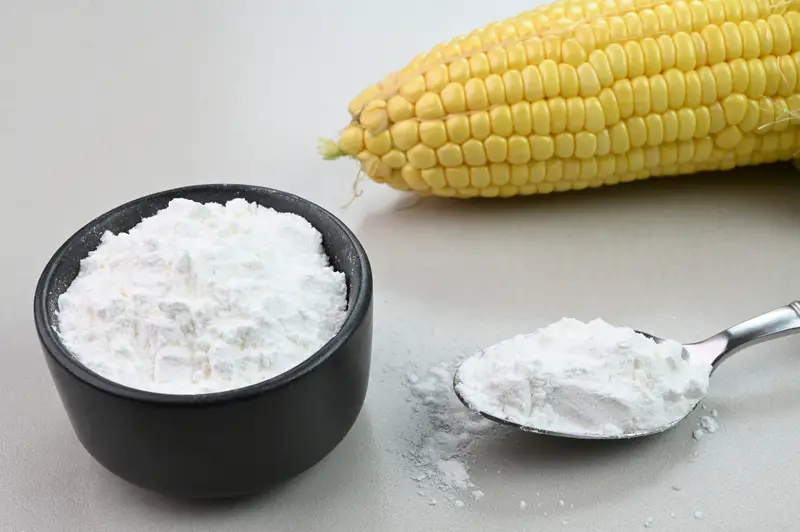Have you ever found yourself staring at a stubborn stain on your carpet and wondering what to do? Or looked at the high price of silver polish at the store and wished for a cheaper option? The answer might be sitting in your pantry right now. Cornstarch, that unassuming white powder you normally use for thickening gravy, actually has amazing cleaning powers that most people don’t know about. This common kitchen ingredient is not only safe and inexpensive, but it’s also surprisingly effective at cleaning everything from greasy stains to tarnished silver.
Grease stains disappear from clothes and upholstery
You’ve just finished eating a delicious pizza when you notice a grease spot on your favorite shirt or couch. Before you panic, reach for the cornstarch. When sprinkled directly onto a fresh grease stain, cornstarch starts working right away, soaking up the oil before it has a chance to set in. The fine, powdery texture of cornstarch creates a large surface area that can absorb many times its weight in oil. This makes it perfect for pulling grease out of fabric fibers where liquid cleaners might just push the stain deeper.
For the best results, cover the entire stain with a thick layer of cornstarch and let it sit for at least 15-20 minutes, though several hours works even better for stubborn spots. You’ll notice the powder starting to clump as it absorbs the oil – that’s how you know it’s working! After the waiting period, simply brush or vacuum away the powder, and wash the item as usual. For really tough stains, you might need to repeat the process, but many people find that even old grease marks can be lightened or removed entirely with this cornstarch trick.
Windows and mirrors become streak-free
If you’re tired of streaky windows and mirrors after cleaning them, cornstarch might be the secret weapon you’ve been looking for. When added to a homemade window cleaning solution, cornstarch works to break down dirt and grime without leaving streaks behind. The tiny particles act as a mild abrasive that helps lift away stubborn spots, while also absorbing excess moisture as the solution dries. This leaves your glass surfaces crystal clear without the need for constant buffing or wiping that can lead to lint residue and streaks.
To make your own streak-free window cleaner, mix 2 tablespoons of cornstarch with 1/2 cup of white vinegar and 4 cups of warm water in a spray bottle. Shake well before each use, as the cornstarch will settle at the bottom. Spray the solution onto your windows or mirrors and wipe with a microfiber cloth or crumpled newspaper for the best results. The vinegar cuts through grime while the cornstarch absorbs oils and prevents streaking. Many people who switch to this method find they never go back to commercial glass cleaners, especially since this homemade version costs just pennies per batch.
Silver becomes shiny without harsh chemicals
Tarnished silver can look dull and old, but commercial silver polishes often contain harsh chemicals and come with a hefty price tag. When you clean silver with cornstarch, something pretty amazing happens. The mild abrasive quality of cornstarch particles helps to gently buff away tarnish without scratching the delicate silver surface. Unlike some commercial cleaners that can strip away a thin layer of silver with each use, cornstarch polish is gentle enough for regular use, even on antique or heirloom pieces.
Creating a silver polish with cornstarch is simple: mix equal parts cornstarch and water to form a thick paste. Apply this paste to your tarnished silver items using a soft cloth or your fingers, rubbing gently in circular motions. Let the paste dry completely on the silver, which usually takes about 15-20 minutes. Once dry, buff the item with a clean, soft cloth to remove the dried paste and reveal the shine underneath. The results are often comparable to expensive silver polishes, but without the chemical smell or risk of damaging your precious items. Many people are shocked by how effectively this simple kitchen ingredient can restore the luster to their silver items.
Carpet odors vanish without perfumed products
Smelly carpets are a common household problem, especially if you have pets or kids. Store-bought carpet fresheners often just mask odors with strong perfumes that can trigger allergies or asthma. When you sprinkle cornstarch on your carpet, it starts working right away to absorb the moisture and oils that trap odors. The tiny particles get down deep into carpet fibers where many odor-causing bacteria live. As the cornstarch sits on your carpet, it acts like thousands of tiny sponges, pulling out not just surface odors but deep-down smells too.
For best results, sprinkle a generous amount of cornstarch across your carpet, making sure to cover any particularly smelly areas well. Let it sit for at least 30 minutes, though overnight is even better if you can manage it. Then simply vacuum thoroughly to remove all the powder. Many people mix in a bit of baking soda with the cornstarch for extra odor-fighting power, especially for pet odors. The best part about this method is that it leaves your carpets truly fresh, not just covered up with artificial scents. Parents of young children and pet owners often prefer this natural approach since there’s no worry about harmful residues left behind that might be touched or ingested by curious little ones or furry friends.
Wood furniture gets a streak-free polish
Dusty wood furniture can make even the cleanest room look neglected, but many commercial furniture polishes leave behind a sticky residue that actually attracts more dust. When you polish wood with a cornstarch mixture, you’ll notice that the wood develops a natural shine without any waxy buildup. The fine cornstarch particles fill in tiny scratches and imperfections in the wood surface, creating a smoother appearance that reflects light better. This gives your furniture that warm glow without the slippery feeling that oil-based polishes leave behind.
To make a simple wood polish, mix 1 tablespoon of cornstarch with 2 tablespoons of water and 1 tablespoon of olive oil. Apply this mixture to your wooden furniture using a soft cloth, rubbing in the direction of the wood grain. Let it sit for about 5 minutes, then buff with a clean cloth until shiny. The water in the mixture helps the cornstarch spread evenly, while the olive oil provides moisture to the wood. Unlike commercial polishes that can build up over time and turn cloudy, this natural polish is easy to apply evenly and won’t leave residue. Many microfiber cleaning cloth users notice that their furniture stays dust-free longer after using this cornstarch polish.
Greasy pots and pans become spotless
After cooking a big meal, you’re often left with greasy pots and pans that seem impossible to clean. Regular dish soap sometimes struggles with heavy grease, leaving a residue that can be felt even after washing. When you sprinkle cornstarch on greasy cookware, it immediately starts to absorb the oil, making it much easier to clean. The cornstarch actually changes the consistency of the grease, turning it from a slippery substance that slides around to a thicker paste that can be wiped away. This makes the cleaning process faster and more effective.
To clean greasy cookware, first remove any food chunks, then sprinkle cornstarch directly onto the greasy surface while it’s still warm (not hot). Let it sit for about 5 minutes as it absorbs the grease, then scrub with your regular dish soap and water. You’ll notice that the grease wipes away much more easily, and your cookware rinses cleaner without that stubborn greasy film. This trick works especially well on cast iron pans after frying foods, and on baking sheets that have baked-on oils. Many home cooks who try this method are surprised by how much less scrubbing is needed, and how their cookware looks newer and cleaner over time as they avoid grease buildup.
Stuffed animals and plush toys become fresh again
Kids’ favorite stuffed animals can get dirty and smelly, but many can’t go in the washing machine without getting damaged. If your child has a beloved teddy bear that’s looking grimy, cornstarch can help freshen it up without water. When you apply cornstarch to plush toys, it works by absorbing oils, sweat, and other substances that cause odors and dinginess. The fine powder gets between the fibers of the fabric, lifting dirt that would otherwise stay trapped. This dry cleaning method is especially good for delicate or vintage stuffed animals that might fall apart in water.
To clean a stuffed animal with cornstarch, place it in a large paper bag with about 1/2 cup of cornstarch. Close the bag tightly and shake it vigorously for 1-2 minutes, making sure the cornstarch reaches all parts of the toy. Let it sit in the bag for about 15-20 minutes so the powder can absorb oils and odors, then take it out and brush off the excess cornstarch with a soft brush or clean toothbrush. For best results, finish by vacuuming the toy with your vacuum’s upholstery attachment to remove any remaining powder. Parents are often amazed at how much cleaner and fresher the toys look and smell after this simple treatment, and kids are happy to have their favorite friends back without having to wait for them to dry after washing.
Shoes stop smelling with a simple treatment
Stinky shoes are embarrassing and unpleasant, but many shoe deodorizers contain strong fragrances or chemicals. When you sprinkle cornstarch inside smelly shoes, it gets to work immediately on the source of the odor rather than just covering it up. The cornstarch absorbs moisture from sweat, which is what bacteria feed on to create bad smells. By reducing the dampness inside shoes, cornstarch creates an environment where odor-causing bacteria can’t thrive. This makes it especially effective for athletic shoes, work boots, and other footwear that tends to get sweaty.
For best results, sprinkle a generous amount of cornstarch inside each shoe at the end of the day and let it sit overnight. In the morning, simply shake out the excess powder before wearing. For particularly smelly shoes, you can mix the cornstarch with a little baking soda for extra odor-fighting power. Many people make this a regular habit with their most-worn shoes, applying the cornstarch every few days to prevent odors from developing in the first place. Athletes and people who work on their feet all day often notice a dramatic difference in how fresh their shoe deodorizer smells after switching to this natural method, and appreciate not having to replace shoes as often due to persistent odors.
Next time you’re facing a cleaning challenge, check your pantry before heading to the store. That container of cornstarch might be all you need to tackle everything from greasy stains to smelly shoes. It’s economical, versatile, and free from harsh chemicals – making it perfect for households with kids, pets, or anyone concerned about using gentler cleaning methods. Your grandmother was right all along: sometimes the simplest solutions really are the best.

